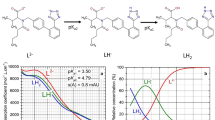Abstract
Purpose. The objective of this study was to compare the results of anormal saturation shake-flask method to a new potentiometricacid-base titration method for determining the intrinsic solubility and thesolubility-pH profiles of ionizable molecules, and to report thesolubility constants determined by the latter technique.
Methods. The solubility-pH profiles of twelve generic drugs (atenolol,diclofenac.Na, famotidine, flurbiprofen, furosemide,hydrochlorothiazide, ibuprofen, ketoprofen, labetolol.HCl, naproxen, phenytoin, andpropranolol.HCl), with solubilities spanning over six orders ofmagnitude, were determined both by the new pH-metric method and by atraditional approach (24 hr shaking of saturated solutions, followed byfiltration, then HPLC assaying with UV detection).
Results. The 212 separate saturation shake-flask solubilitymeasurements and those derived from 65 potentiometric titrations agreed well.The analysis produced the correlation equation:log(1/S)titration = ±0.063(± 0.032)+ 1.025(±0.011) log(1/S)shake-flask,s = 0.20, r2 = 0.978.The potentiometrically-derived intrinsic solubilities of the drugs were:atenolol 13.5 mg/mL, diclofenac.Na 0.82 μg/mL, famotidine 1.1mg/mL, flurbiprofen 10.6 μg/mL, furosemide 5.9 μg/mL,hydrochlorothiazide 0.70 mg/mL, ibuprofen 49 μg/mL, ketoprofen 118 μg/mL,labetolol.HCl 128 μg/mL, naproxen 14 μg/mL, phenytoin 19 μg/mL, andpropranolol.HCl 70 μg/mL.
Conclusions. The new potentiometric method was shown to be reliablefor determining the solubility-pH profiles of uncharged ionizable drugsubstances. Its speed compared to conventional equilibriummeasurements, its sound theoretical basis, its ability to generate the fullsolubility-pH profile from a single titration, and its dynamic range (currentlyestimated to be seven orders of magnitude) make the new pH-metricmethod an attractive addition to traditional approaches used bypreformulation and development scientists. It may be useful even todiscovery scientists in critical decision situations (such as calibratingcomputational prediction methods).
Similar content being viewed by others
REFERENCES
C. A. Lipinski, F. Lombardo, B. W. Dominy, and P. J. Feeney. Experimental and computational approaches to estimate solubility and permeability in drug discovery and development settings. Adv. Drug Del. Rev. 23:3–25 (1997).
B. D. Anderson and K. P. Flora. Preparation of water-soluble compounds through salt formation. In: Wermuth, C. G. (Ed.), The Practice of Medicinal Chemistry. Academic Press, London, pp. 739–754, 1996.
J. I. Wells. Pharmaceutical Preformulation: The Physicochemical Properties of Drug Substances; Ellis Horwood Ltd.: Chichester, 1988.
A. Avdeef. pH-Metric Solubility. 1. Solubility-pH Profiles from Bjerrum Plots. Gibbs Buffer and pKa in the Solid State. Pharm. Pharmacol. Commun. 4:165–178 (1998).
T. J. Roseman and S. H. Yalkowsky. Physicochemical properties of prostaglandin F2a (tromethamine salt): solubility behavior, surface properties, and ionization constants. J. Pharm. Sci. 62:1680–1685 (1973).
J. J. Kaufman, N. M. Semo, and W. S. Koski. Microelectrometric Titration Measurement of the pKas and Partition and Drug Distribution Coefficients of Narcotics and Narcotic Antagonists and their pH and Temperature Dependence. J. Med. Chem. 18:647–655 (1975).
W. H. Streng and M. A. Zoglio. Determination of the Ionization Constants of Compounds which Precipitate During Potentiometric Titration Using Extrapolation Techniques. J. Pharm. Sci. 73:1410–1414 (1984).
D. Todd and R. A. Winnike. A rapid method for generating pH-solubility profiles for new chemical entities. Abstr. 9th Ann. Mtng., Amer. Assoc. Pharm. Sci., San Diego (1994).
G. L. Amidon, H. Lennernäs, V. P. Shah, and J. R. Crison. A Theoretical Basis for a Biopharmaceutic Drug Classification: the Correlation of In Vitro Drug Product Dissolution and In Vivo Bioavailability. Pharm. Res. 12:413-420 (1995).
Guidance for Industry, Immediate Release Solid Oral Dosage Forms, Scale-Up and Post Approval Changes: Chemistry, Manufacturing and Controls, In Vitro Dissolution Testing, and In Vivo Bioequivalence Documentation, CDER, Food and Drug Administration, USA, 1995.
Waiver of In Vivo Bioavailability and Bioequivalence Studies for Immediate Release Solid Oral Dosage Forms Containing Certain Active Moieties/Active Ingredients Based on a Biopharmaceutics Classification System. Federal Register 64:7897.
United States Pharmacopeia XXI and National Formulary XVI, United States Pharmacopeia Convention, Inc., Rockville, MD, 1985.
A. Avdeef and J. J. Bucher. Accurate measurments of the concentration of hydrogen ions with a glass electrode: calibrations using the Prideaux and other universal buffer solutions and a computer-controlled automatic titrator, Anal. Chem. 50:2137–2142 (1978).
A. Avdeef. Weighting Scheme for Regression Analysis Using pH Data from Acid-Base Titrations. Anal. Chim. Acta 148:237–244 (1983).
P. Isnard and S. Lambert. Aqueous Solubility and n-Octanol/Water Partition Coefficient Correlation. Chemosphere 18:1837–1853 (1989), and references therein.
D. J. W. Grant and T. Higuchi. Solutility Behavior of Organic Compounds. John Wiley & Sons: New York, pp. 385–388, 474–486, 1990.
A. Avdeef and K. J. Box. Sirius Technical Application Notes. Vol. 2, Sirius Analytical Instruments Ltd.: Forest Row, E. Sussex, UK, 1996.
B. D. Anderson and R. A. Conradi. Predictive Relationships in the Water Solubility of Salts of a Nonsteroidal Anti-Inflammatory Drug. J. Pharm. Sci. 74:815–820 (1985).
Z. T. Chowhan. pH-Solubility Profiles of Organic Carboxylic Acids and Their Salts. J. Pharm. Sci. 67:1257–1260 (1978).
Author information
Authors and Affiliations
Rights and permissions
About this article
Cite this article
Avdeef, A., Berger, C.M. & Brownell, C. pH-Metric Solubility. 2: Correlation Between the Acid-Base Titration and the Saturation Shake-Flask Solubility-pH Methods. Pharm Res 17, 85–89 (2000). https://doi.org/10.1023/A:1007526826979
Issue Date:
DOI: https://doi.org/10.1023/A:1007526826979




